[Eng-Esp] Amazing Nature Contest - August 2020 - #03- My cacti and succulents / Mis cactus y suculentas.
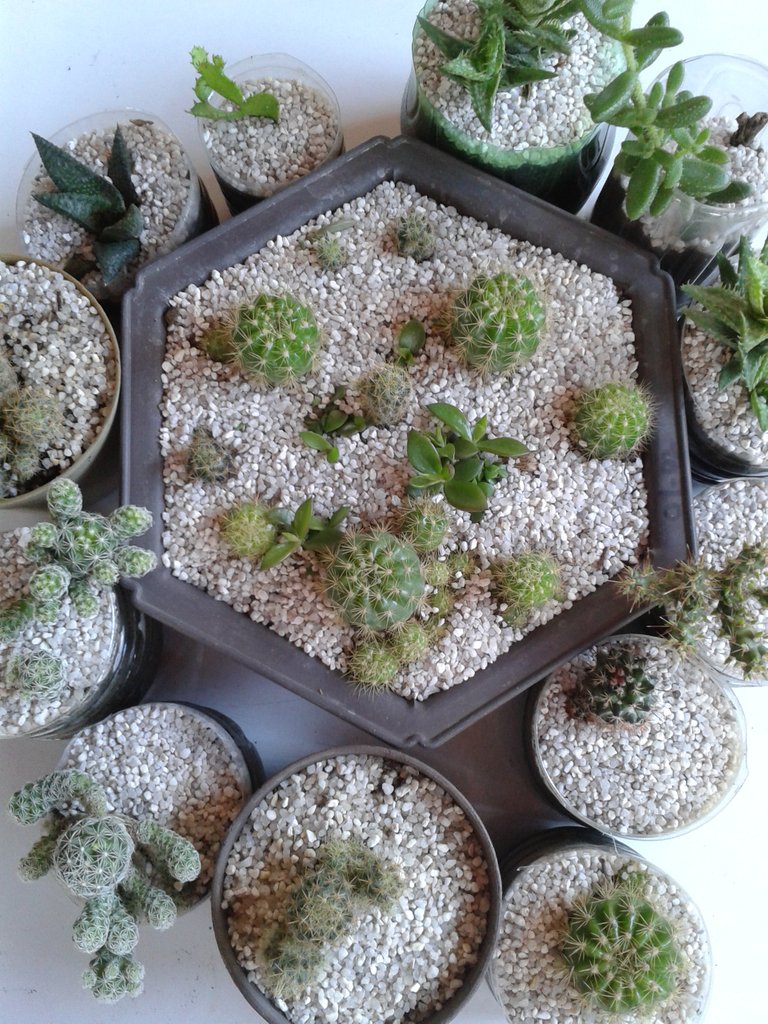
Many people already know me as a fervent admirer of nature, I have been dedicating myself to my plants for many years, since I was a child, I had the pleasure of sowing, harvesting and transplanting. As a legacy from my mother and her European culture.
So, little by little, over the years I have accumulated many plants, among them are my cacti and succulents. I have more than a hundred cacti planted by me but not so many species, I must barely have 30 species of them.
But I can replicate them successfully. I have never classified them before and am starting to do so. Thanks to the idea of my friend @adalger, today I have my first classified cacti and succulents and I gathered them as an entry to the beautiful contest of @amazingnature, hosted by @adalger.
1.- Opuntia Cylíndrica:
This is a cactus that belongs to the cacti family, its genus is Cylindropuntia.
She is originally from Mexico, Ecuador and Chile.
It's a highly branched or shrubby cactus. Straight-stemmed and cylindrical in shape, with many sharp spines approximately 1 cm long all over its surface. It has white areolas from where the thorns start.
It has numerous green extensions, similar to leaves, very close to the position of the spines.
It's directly exposed to the sun and has little humidity in its land.
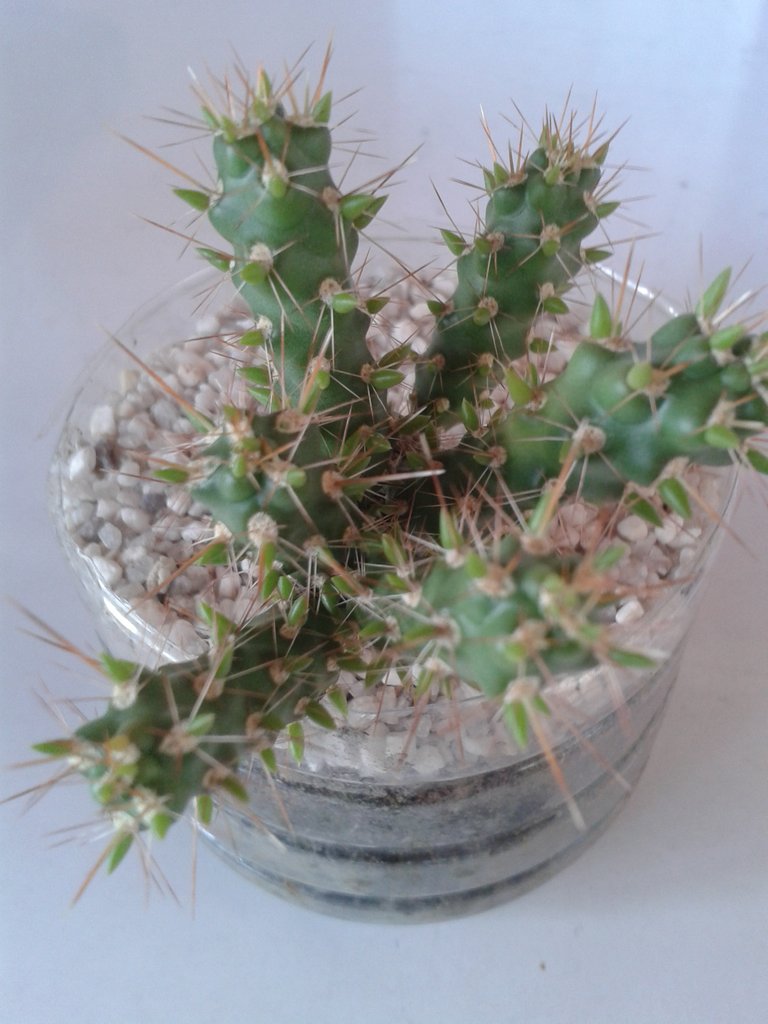
2.- Rebutia Cactus:
This one is a cactus of the Cactaceae family. Genus Rebutia. It is also well known as Sulcorebutia.
Its origin is from Argentina and Bolivia.
They are fast growing and very prolific, developing many children around them. It's rounded, columnar, cylindrical and flattened above. With abundant short, radiated spines.
It must have direct exposure to the sun for it to flower and develop. Its land must have good drainage. It also does not support excess liquid as its roots and stem rot.
For its multiplication it's best to remove one of its suckers and transplant it directly into a pot, store it in the shade for a few days and then gradually expose to the sun.
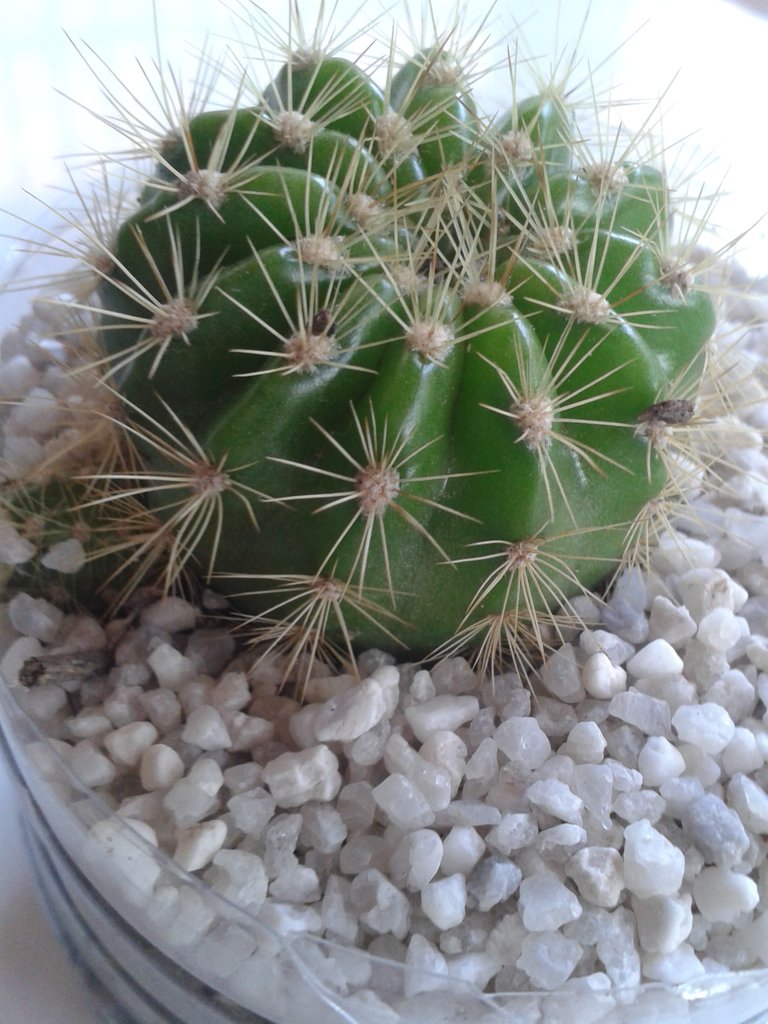
3.- Sedum Nussbaumerianum:
It belongs to the cacti family. Its genus is the Sedum and the species is the Nussbaumerianum.
It is originally from Mexico.
This one is a succulent plant with a thin, small and fragile stem. Light green, grayish or brown in color. This stem is surrounded by rosettes of fleshy, elongated leaves. 2 to 3 cm long.
It can grow with direct sun exposure but it also tolerates semi-shade. The color of its leaves varies according to its exposure to the sun. They are light green in the shade and copper to red in the sun.
They form a very lush and multi-colored shrub with lots of color.
They reproduce through the suckers with roots or through their leaves. When placed on the ground in a horizontal position and detached from its mother plant, it will reproduce in a plant with the same characteristics of the mother plant.
It likes its moist substrate and fertilized soil for cacti and succulents.
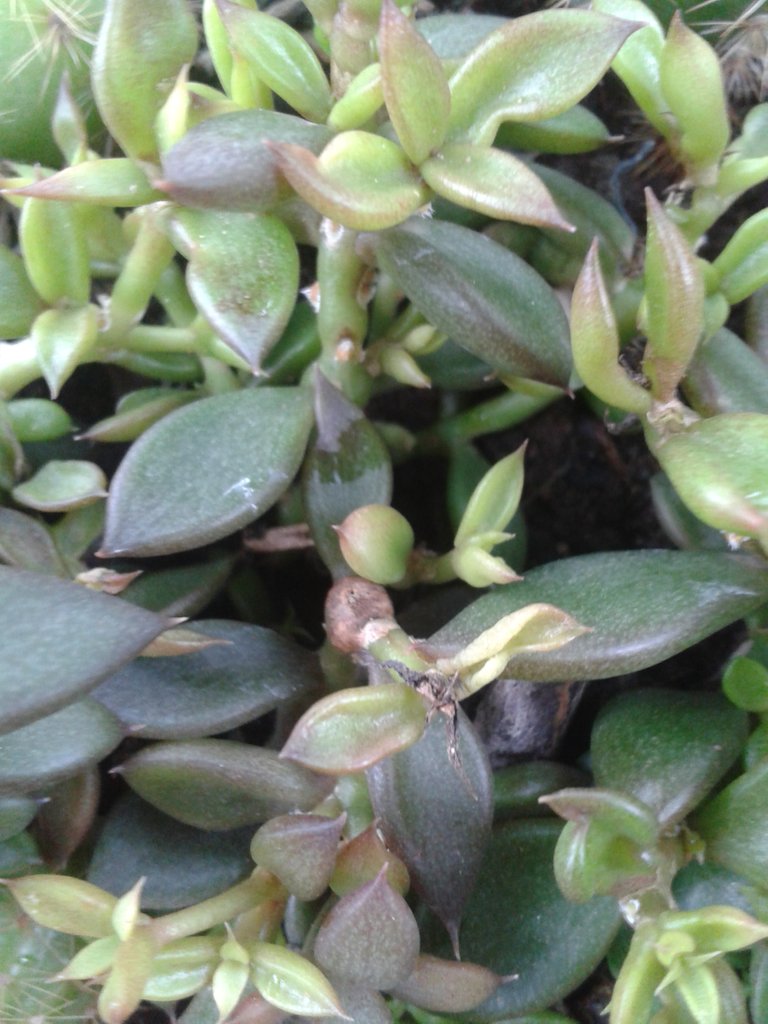
4.- Haworthia Limifolia:
This is a succulent that belongs to the xanthorrnoeaceae family, its genus is Haworthia and its species Limifolia.
Its common name is succulent crocodile skin. It is native to Africa.
Its leaves are rigid and with grooves that give it a rough texture and they can be compared to the skin of a crocodile. They grow in the form of a rosette. They are wide leaves and make a depression in the center and then fall towards the tip of the leaf. The plant does not reach more than 30 cm in height.
Its semi-shadowy color is light green and when exposed to the sun it can change its color darkening or whitening its leaves, its leaves can even be burned when being directly in the sun.
For its flowering the floral rod emerges from its center. Approximately 30 cm long and at its distal end it presents yellowish-green bell-shaped inflorescences.
Reproducing this plant is quite easy. The children of the mother plant are separated. Which are observed between its leaves or at the level of the union of the leaves in contact with the earth. It can also grow from the leaves.
The plant child is placed in a pot with soil and with organic compost and sand for good drainage.
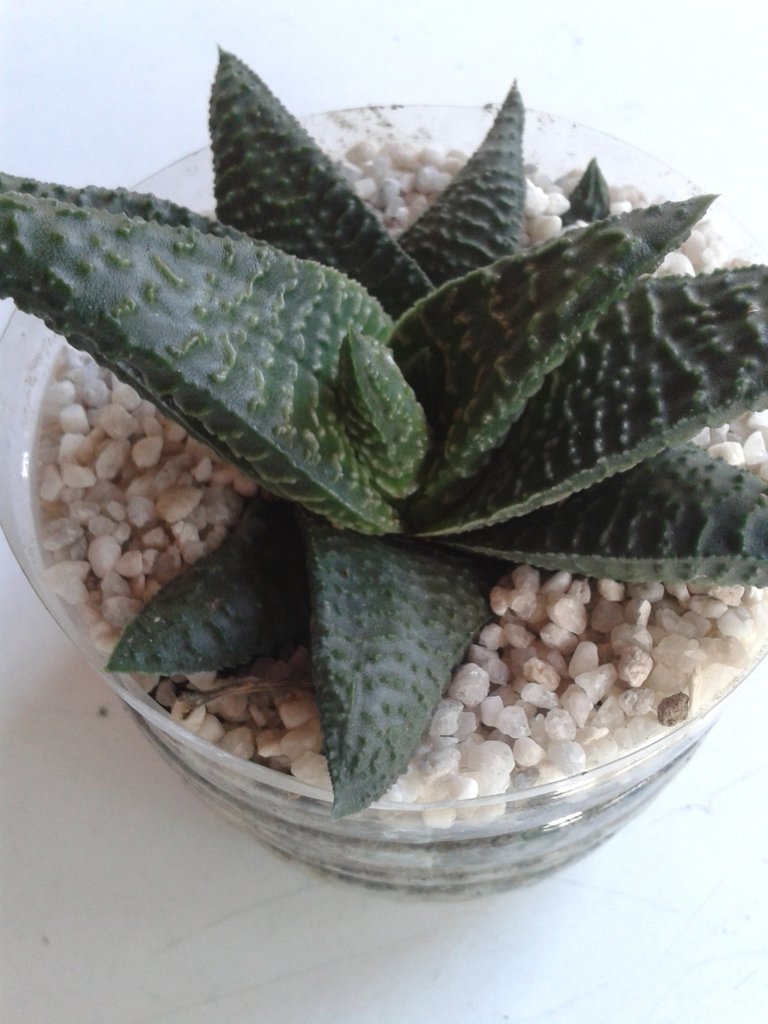
5.- Aloe Juvenna:
It's a succulent plant that belongs to the Xanthorrnoeaceae family, its genus is Aloe and its species Juvenna.
It is native to Africa.
Its common name is Aloe Tiger tooth.
The plant grows in the form of a column. The thick, green leaves with white speckles come together in a rosette. The sides of these leaves are full of small spines that grow inwards and this gives the origin of its popular name Tiger's tooth.
It grows very well even with little sun exposure, but he would rather be in the semi-shadow. If they are exposed to the sun directly, the green color of their leaves darkens. The plant grows forming a column that falls with the weight.
The children grow from the stem of the plant attached to the earth and they are agglomerating around the mother plant. Being a very striking aspect when wanting to beautify a pot.
The reproduction of the plant is carried out in a better way by obtaining the children of the plant. It's very easy to handle them when transplanting. You only need to separate a child, with or without a root, and then transplant into a pot with the same conditions as the mother plant.
Then it must be kept in the shade for a week and then it can be placed in the semi-shade. Or with direct exposure to the sun so long as you take precautions to not burn its leaves.
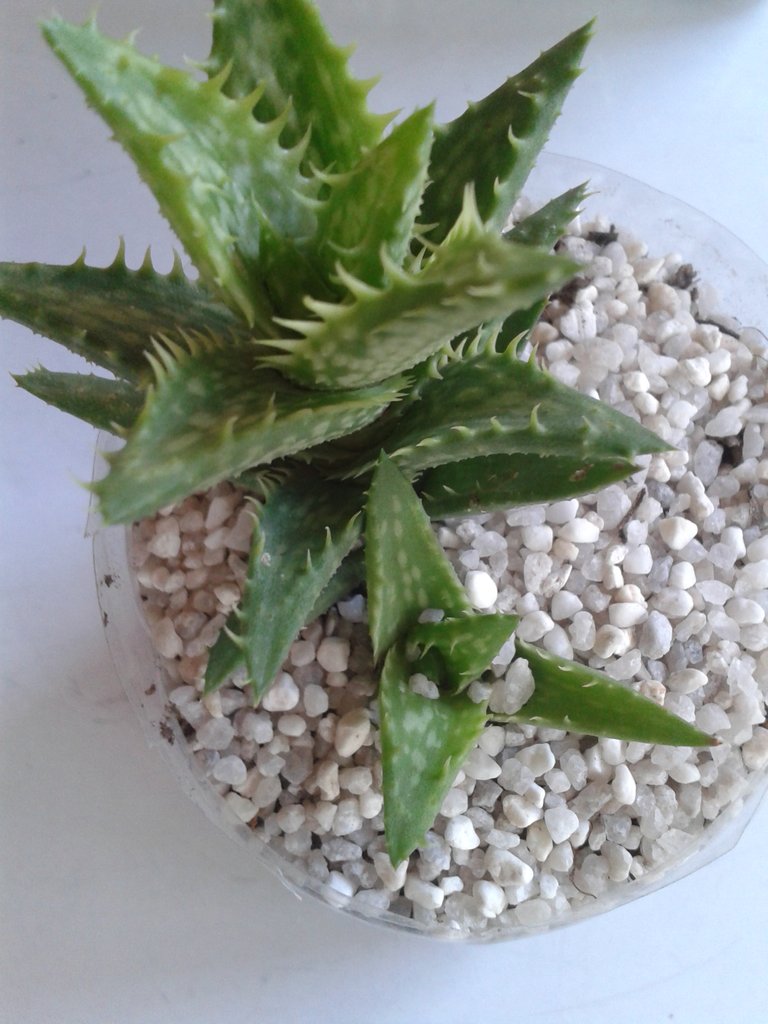
6.- Euphorbia lactea Cristata:
It belongs to the Euphorbiaceae family, the genus Euphorbia and the milky species Cristata.
She is a native of India.
This one is a succulent with the common name of The Candelabra Plant.
The stem is thick, tortuous which gives it the impression of being wrinkled. It develops in such a way that it is thin at the bottom and thickens as it grows. This formation, because it is similar to the Candelabra, is what gives it its popular name. It can exceed 4 meters in height.
On the surface of its stem, in the form of a fan, it presents inflorescences that grow in the form of a wavy crest. With direct exposure to the sun these ridges show a red coloration.
When splitting the stem it releases a sticky white latex that is toxic,
It can be easily reproduced by branches of its stem. They are cut from the oldest stem.
In pots they can reproduce very well.
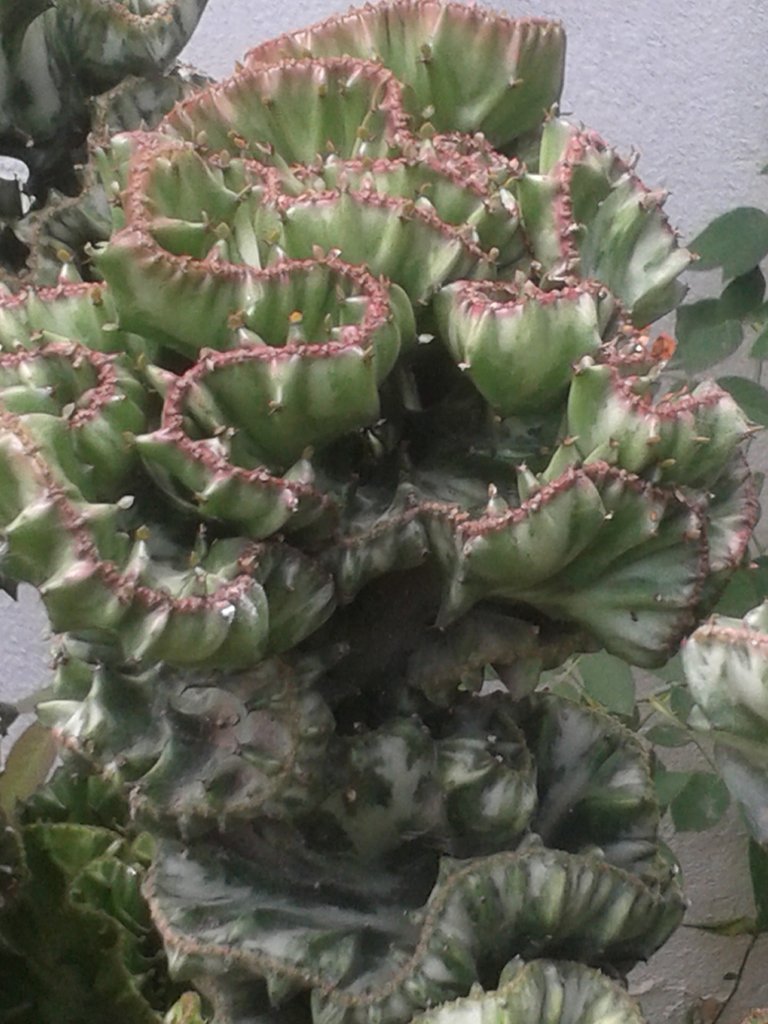
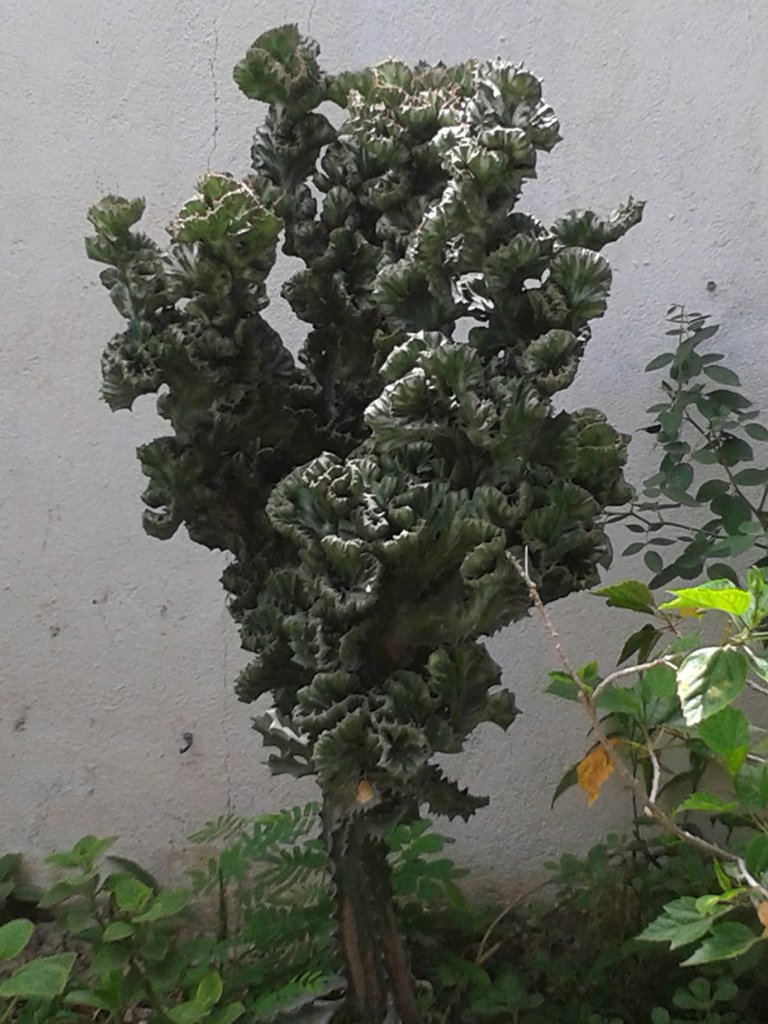
7.- Graptopetalum Paraguayense:
It belongs to the crassulaceae family. Its genus is Graptopétalum and its species is Paraguayan.
It's native to Paraguay, hence its species.
The Graptopétalum name refers to its leaves that are slightly spotted in a grayish-white and pinkish coloration.
Also called Mother Pearl or Ghost Plant. The leaves of this plant are arranged in the form of rosettes. Its leaves are long and thick. These leaves have a color between green and gray or pink, with exposure to the sun.
Requires direct exposure to full sun. They withstand medium temperatures if they do not receive significant contributions of water.
It is a plant that reproduces in any soil. It supports little humidity from its soil. Without excessive watering, since the roots rot.
Although they can be multiplied with seeds, the fastest method is by using branches of the stem or its leaves. It's very easy due to its ease of rooting.
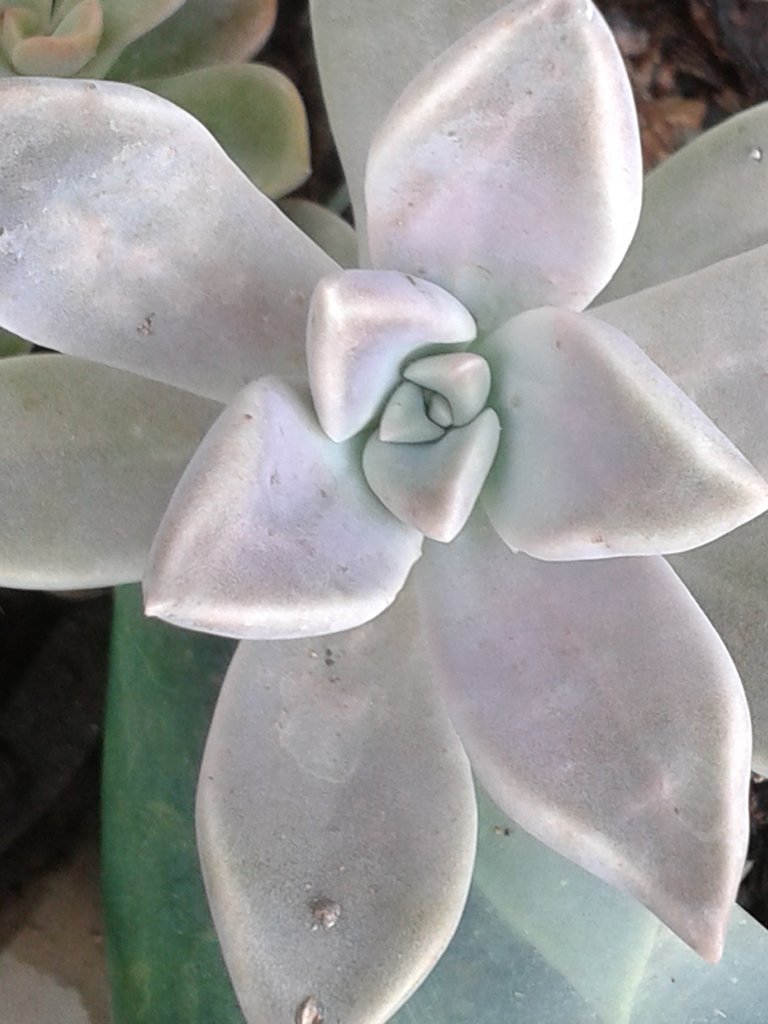
8.- Graptoveria Fenix:
It belongs to the crássulaceaes, its genus is Graptoveria and its species Fénix.
It comes from Argentina.
It is a plant with many characteristics similar to Graptopetallum. With thick stems. Rounder but just as fleshy leaves. Grayish in color. They are arranged in the form of a rosette and agglomerates. The plant is not tall. Its size does not exceed 40 cm. It is usually rather creepy. Since it has erect stems and the proliferation of rosettes make the plant become undulating and fall due to the weight.
Direct exposure to the sun allows its leaves to take on various types of colors, including red.
If the plant is subjected to semi-shade, its rosette shape disappears and takes another shape, with widely separated leaves. The leaves separate into an erect and rigid stem without proliferation of suckers.
They do not stand very well for long periods without moist soil. But too much water rots its roots.
Its reproduction is done through suckers. They are removed from the mother plant and placed in the pot. It can also reproduce through the leaves.
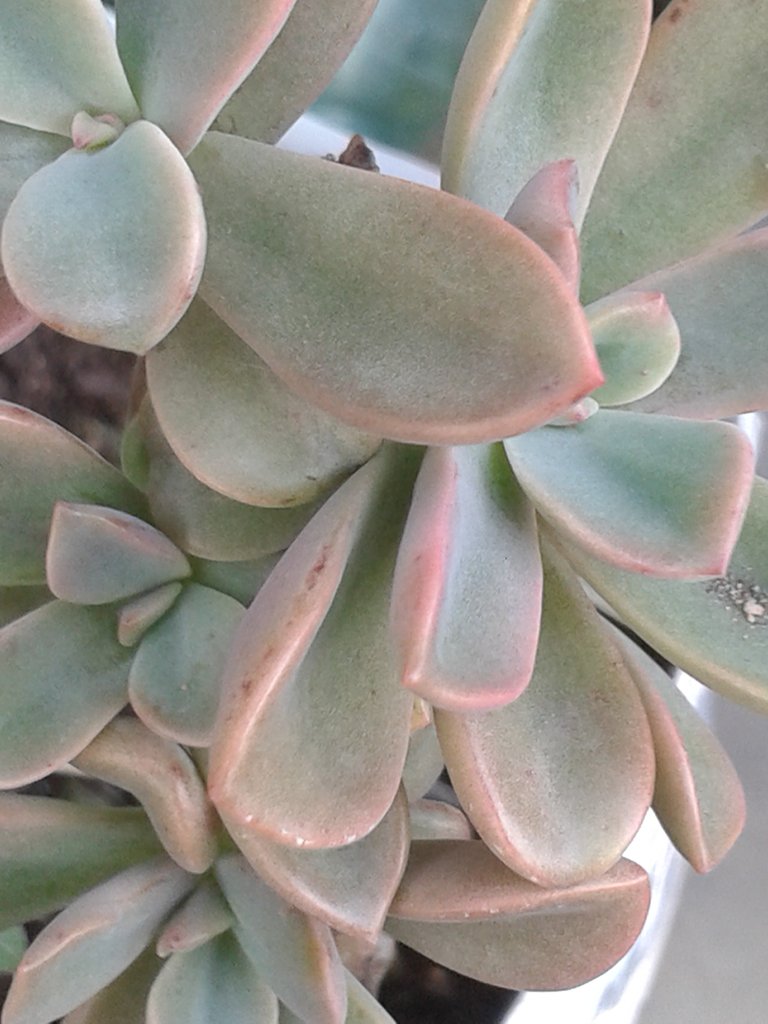
I sheltered these plants from heavy rains and put them in the shade. After a few weeks I realized that its leaves have dispersed due to the lack of direct sunlight. Here they lose their original appeal. It will no longer be able to regroup its agglomerated leaves, but I will place them back in the sun, so that they will be able to cover their empty spaces with suckers. In time I will see its progress.
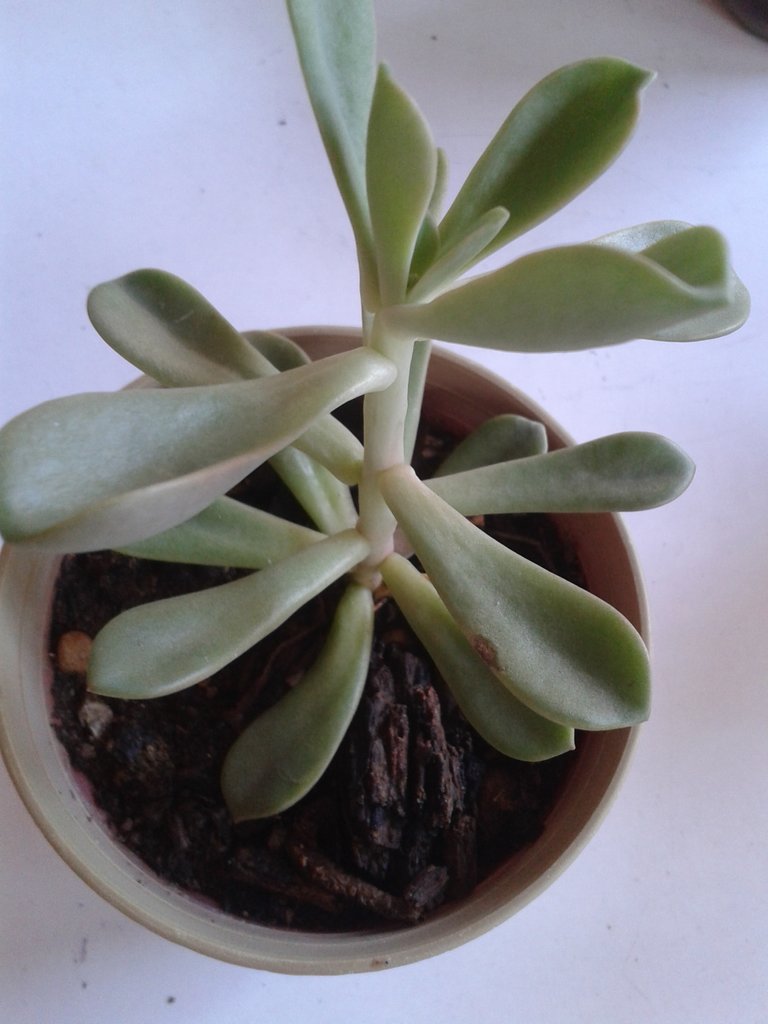
9.- The Sedum Morganianum:
It belongs to the Crassulaceae family, the genus is Sedum and the Morganianum species.
He is originally from Mexico.
It is called the Succulent Burrito, or Donkey's tail. Its stem is formed by the union of its small leaves, they do not exceed three cm in length. They are fleshy and elongated.
They grow very close together forming long stems of more than 30 cm. They are apple green when not in the sun and bluish green when in direct contact with it. Prefers semi-shadow.
Substrate conditions must have relative humidity and good drainage.
By this date it has this size and color.
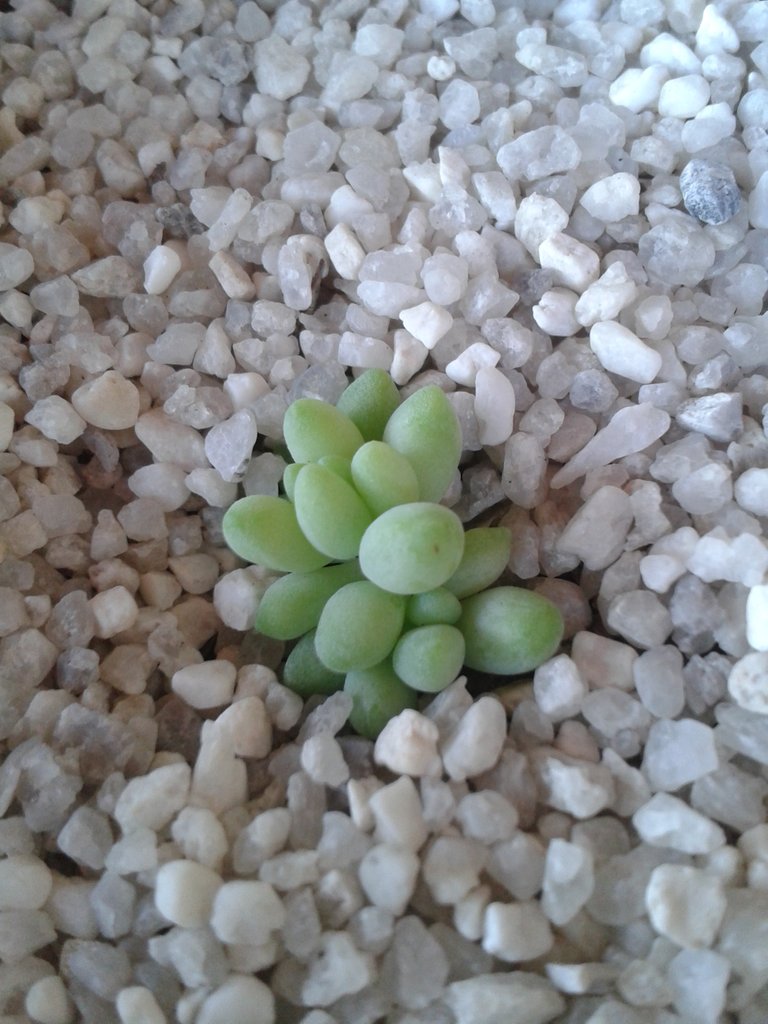
This succulent has grown from a fallen leaf. Since last year, 2019, it has been growing little by little in semi-shadow. I have been following its development until now.
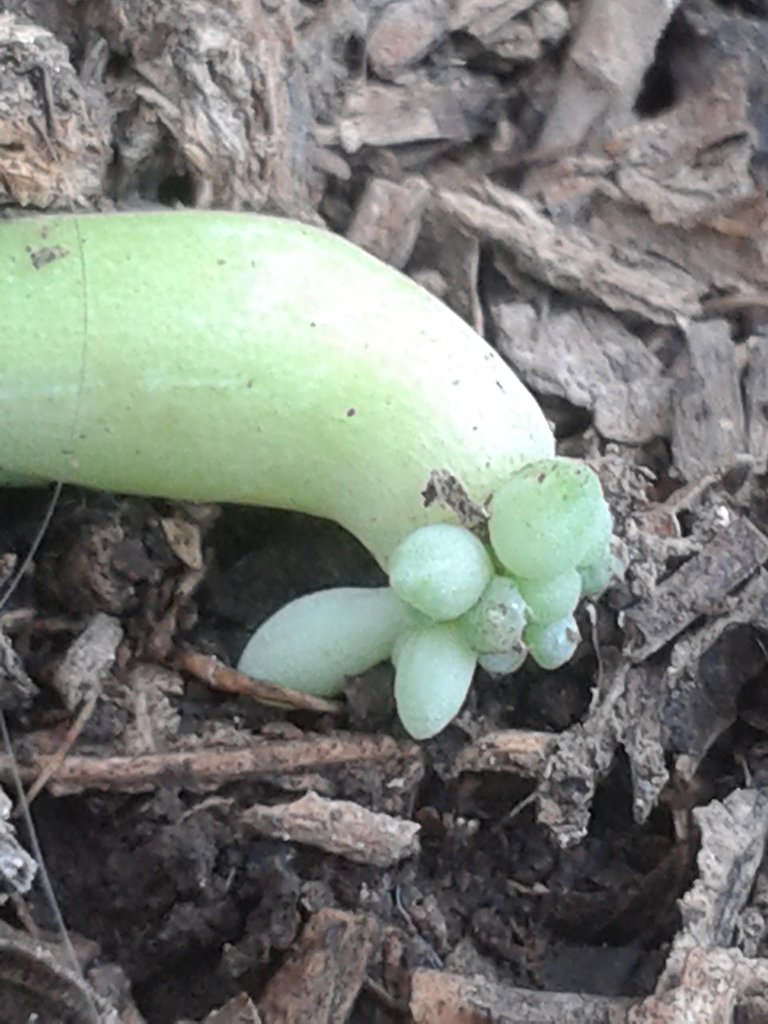
10.- Opuntia Microdasys:
This one belongs to the cactasseae family, the genus is Opuntia and the species Microdasys.
They are originally from Mexico. Their common name is Mickey's Ear and/or Angel Wings.
They form the most resistant genus of plants that exist. The body of the Microdasys is formed by the union of their leaves. The stalks or leaves of the cactus grow in the superficial portion of the ears. They are arranged in such a way that they form a very leafy cactus that grows up to 1 m in height.
The leaves are thick, oval, light green in color and with villi all over the cactus surface. These villi are very small spines, which when in contact with the fingers are very unpleasant and difficult to remove.
They like direct exposure to the sun and they do not like the waterlogging of their substrate.
They reproduce easily by removing one of their stalks and proceeding to heal for a week. Then it is placed in the pot in a shady place until it can be exposed directly to the sun.
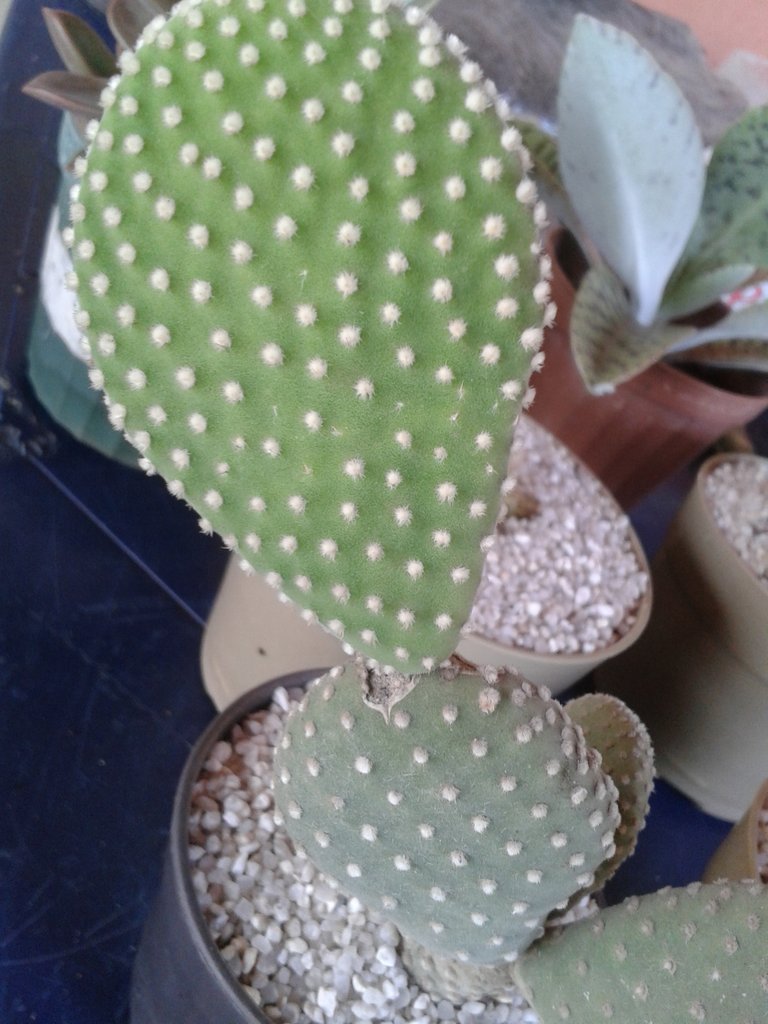
11.- Opuntia Rúfida.
It's another cactaceae of the Opuntias species and its genus Rúfida.
The difference with the Microdasys is the color of the villi. They are red. The rest of the characteristics, reproduction and transplantation are the same of the Microdasys cactus.
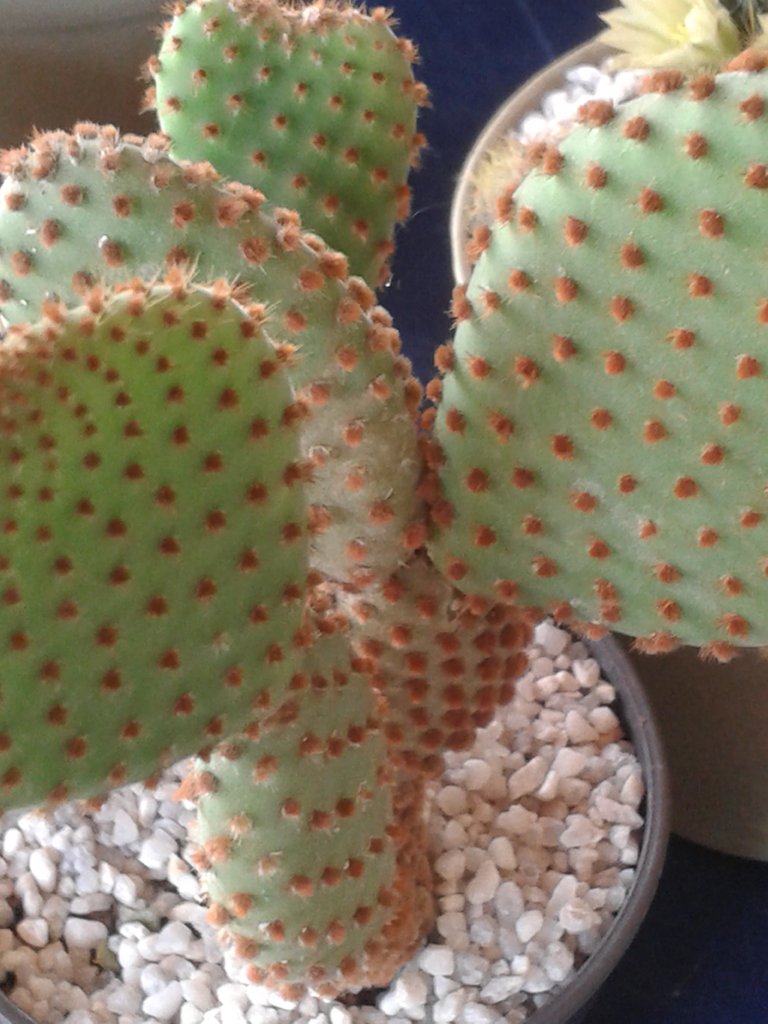

These are some characteristics that I have been obtaining with my experience with the years of cultivation of cacti and succulents. And by doing research on Google, I have been able to obtain and collect information on the species and genera. On many occasions I have not agreed with certain information that I read on the internet, therefore I can only transmit what gives me results and they are what you just read. I hope it helps you if you are interested in planting it, growing it and transplanting it.
All these plants represent my wonderful nature and I hope you can appreciate it.
All photographs are my property.
Taken with my phone Samsung Mini s3.
Thanks for your visit.

Muchas personas ya me conocen como ferviente admiradora de la naturaleza. Llevo muchos años dedicándome a mis plantas. Desde niña y eso hace muchísimo tiempo, tenía el placer de sembrar, cosechar y trasplantar. Como legado de mi madre con cultura Europea.
Así poco a poco con los años he acumulado muchas plantas. Entre ellas están mis cactus y suculentas. Tengo más de cien cactus sembrados por mi. No tantas especies, apenas debo tener 30 especies de ellas.

Pero las replico con éxito. Nunca antes las había clasificado y estoy empezando a hacerlo. Gracias a la idea del amigo @adalger, hoy tengo mis primeros cactus y suculentas clasificados. Y los reuní como entrada a este hermoso concurso de @amazingnature, y quien lo aloja @adalger.
1.- Opuntia Cylíndrica:
Es un cactus que pertenece a la familia de las cactáceas, su género es Cylindropuntia.
Es oríginaria de Mexico, Ecuador y chile.
Es un cactus muy ramificado o arbustivo. De tallo recto y en forma cilíndrica, con muchas espinas filosas de 1 cm de largo aproximadamente, en toda su superficie. Tiene areolas blancas De donde parten las espinas.
Presenta numerosas prolongaciones d color verde, parecidas a hojas muy cerca de la posición de las espinas.
Es de exposición directa al sol y de poca humedad en su tierra.
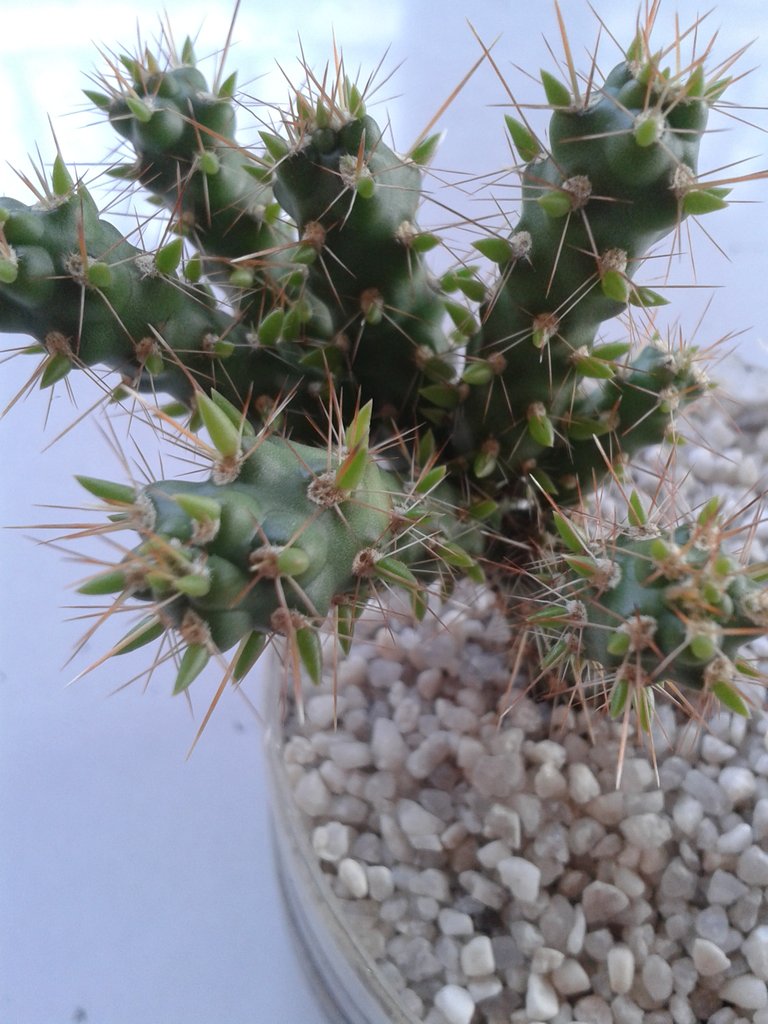
2.- Cactus Rebutia:
Es un cactus de la familia de las cactáceae. Género Rebutia. También es muy conocida como Sulcorebutia.
Su origen es de Argentina y Bolivia.
Son de crecimiento rápido, muy prolíficas que desarrollan muchos hijos a su alrededor. Es de forma redondeada, columnar, cilíndrica y achatada por encima . Con abundantes espinas radiadas y cortas.
Debe tener exposición directa al sol para su floración y desarrollo. Su tierra debe tener buen drenaje. No soporta exceso de líquido pues se pudren sus raíces y su tallo.
Para su multiplicación lo mejor es retirar uno de sus hijuelos y trasplantar directamente en maceta. Resguardar en sombra durante unos días y luego exponer poco a poco al sol.
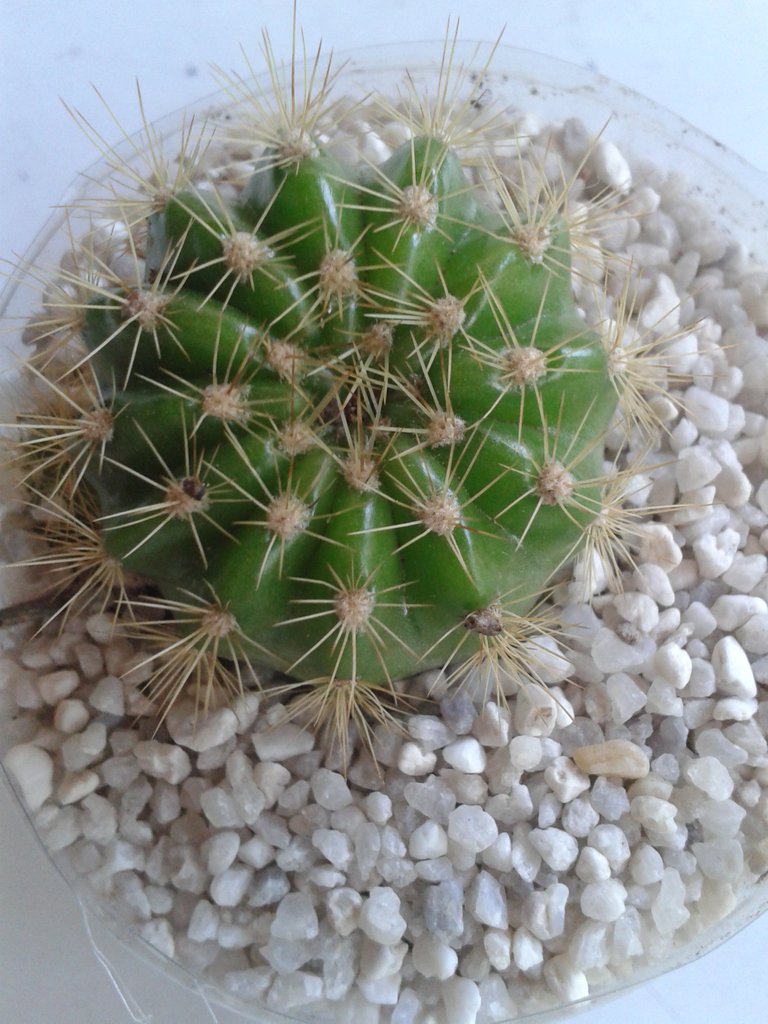
3.- Sedum Nussbaumerianum:
Pertenece a la familia de las cactasseaes. Su género es el Sedum y la especie es el Nussbaumerianum.
Es originaria de Mexico.
Es una planta suculenta de tallo delgado, pequeño y frágil. De color verde claro, grisáceo o marrón. Este tallo es rodeado por rosetas de hojas carnosas, en forma alargada. De 2 a 3 cm de largo.
Puede crecer con exposición directa al sol pero también tolera la semisombra. El color de sus hojas varía según su exposición al sol. Son de color verde claro en la sombra y de color cobrizo a rojo, al sol.
Forman un arbusto muy frondoso y de múltiples plantas con mucho colorido.
Se reproducen a través de los hijuelos con raíces o por medio de sus hojas. Al colocarlas en tierra en posición horizontal y desprendidas de su planta madre, se reproducirá en una planta con las mismas características de la planta madre.
Le agrada su sustrato húmedo y tierra abonada para cactus y suculentas.
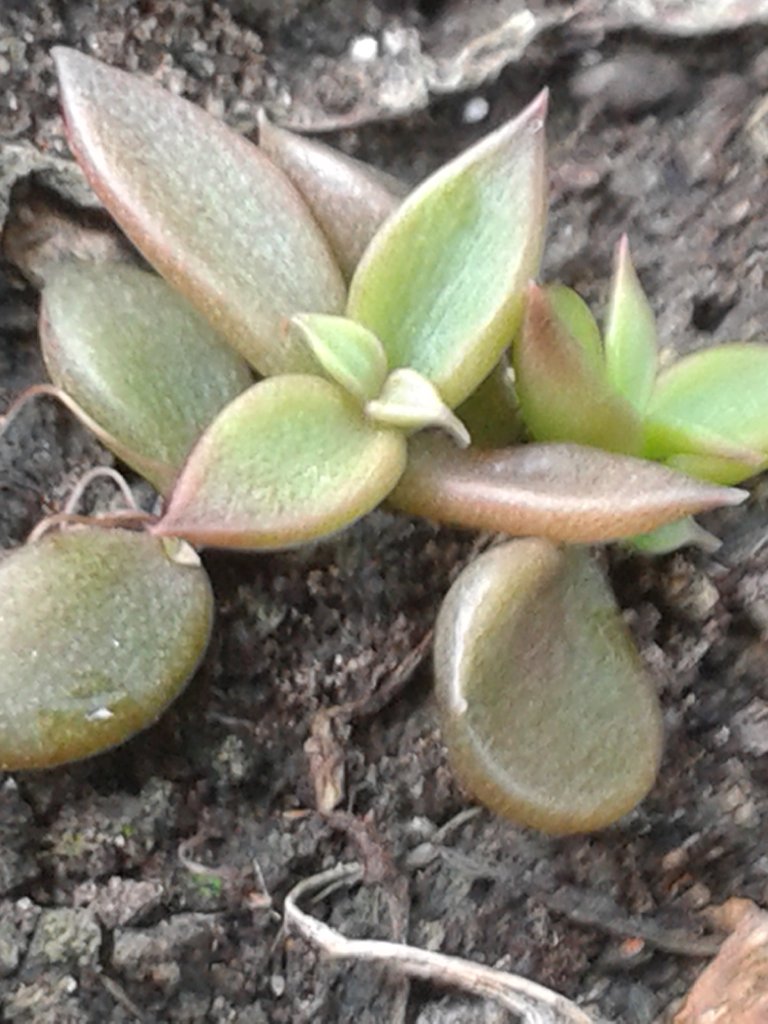
4.- Haworthia Limifolia:
Es una suculenta que pertenece a la familia de las xanthorrnoeaceae, su género es Haworthia y su especie Limifolia.
Su nombre común es suculenta piel de cocodrilo. Es originaria de Africa.
Sus hojas son rígidas y con estrías que le dan la textura áspera y se compara con la piel de un cocodrilo. Crecen en forma de roseta. Son hojas anchas y hacen una depresión en su centro para luego caer haca la punta de la hoja. La planta no llega a superar más de los 30 cm de altura.
Su color en semisombra es verde claro y al pasar a la exposición al sol puede cambiar su color oscureciendo o blanqueando sus hojas incluso se pueden quemar sus hojas al estar directamente al sol.
Para su floración emerge de su centro la vara floral. Con aproximadamente 30 cm de largo y en su extremo distal presenta inflorescencias en forma de campanillas de color verde amarillentas.
La reproducción de esta planta es bastante fácil. Se separan los hijos de la planta madre. Los cuales se observan entre sus hojas o a nivel de la unión de las hojas en contacto con la tierra. También puede proliferar a partir de las hojas.
Se coloca el hijo de la planta en una maceta con tierra y con abono orgánico y arena. Para un buen drenaje.
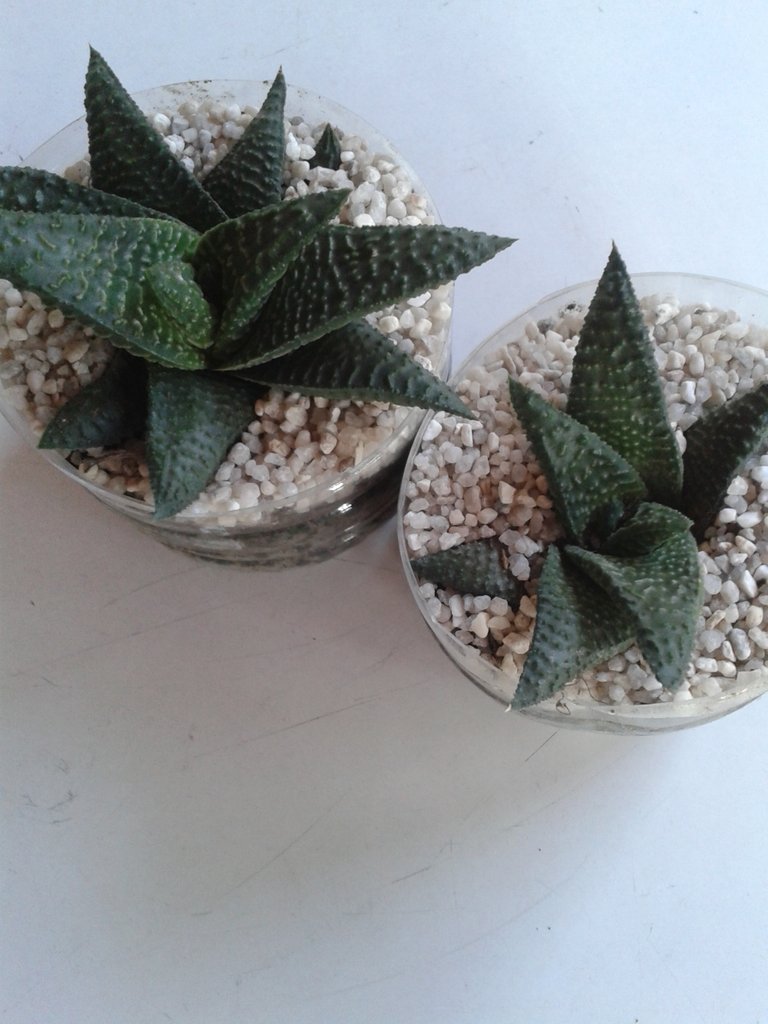
5.- Aloe Juvenna:
Es una planta suculenta que pertenece a la familia de las Xanthorrnoeaceae, su género es Aloe y su especie Juvenna.
Es originaria de África.
Su nombre común es Aloe Diente de Tigre.
La planta crece en forma de columna. Las hojas gruesas y verdes con moteados blancos, se unen en forma de roseta. Los lados de estas hojas están repletos de pequeñas espinas que crecen hacia a dentro y esto le da el origen a su nombre popular Diente de Tigre.
Crece muy bien aun con poca exposición solar. Pero le gusta más bien la semisombra. Si se exponen al sol directamente el color verde de sus hojas se oscurece. La planta crece formando una columna que con el peso cae.
Los hijos van creciendo desde el tallo de la planta unida a la tierra. Y se van aglomerando alrededor de la planta madre. Siendo un aspecto muy llamativo a la hora de querer embellecer una maceta.
La reproducción de la planta se realiza en mejor forma obteniendo los hijos de la planta. Es muy fácil para su manejo al momento de trasplantar. Solo debe separar un hijo, con o sin raíz y luego trasplantar a una maceta con las mismas condiciones que la planta madre.
Luego se debe mantener en sombra por espacio de una semana y después se podrá colocar a la semisombra. O a la exposición directa al sol pero tomando previsiones para no quemar sus hojas.
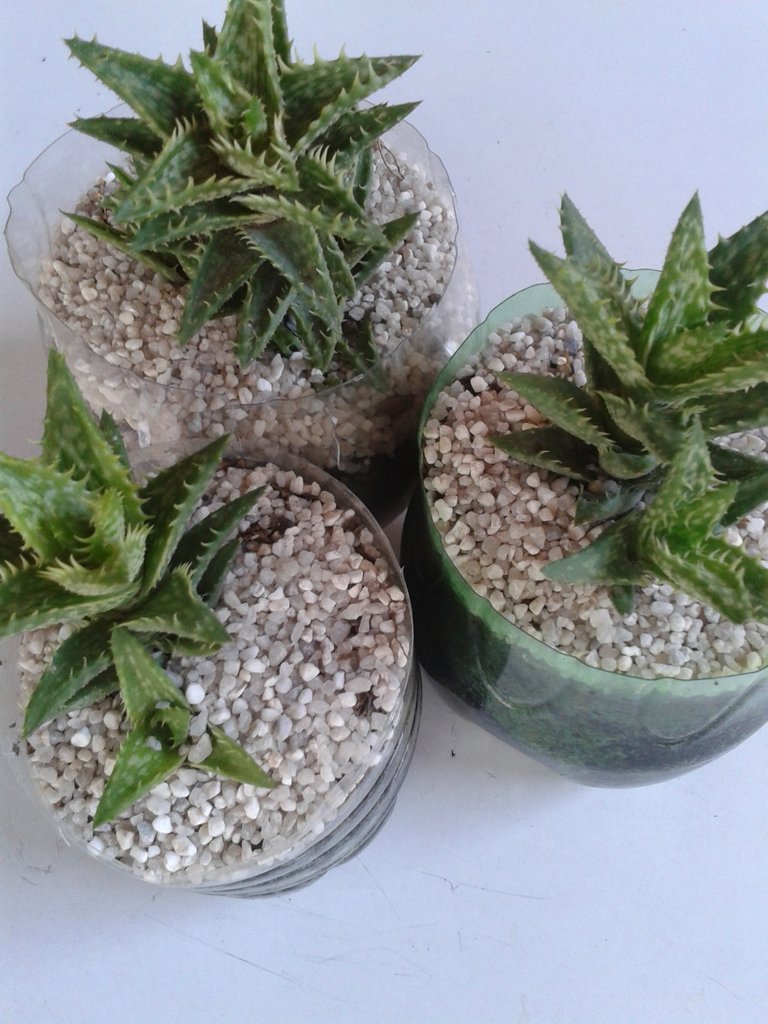
6.- Euphorbia láctea Cristata:
Pertenece a la familia de la Euphorbiaceae, del género Euphorbia y de la especie láctea Cristata.
Es oriunda de la India.
Es una suculenta de nombre común la planta candelabro.
El tallo es grueso, tortuoso lo que le da la impresión de estar arrugado. Se va desarrollando de tal manera que abajo es delgado y se va engrosando a medida que va creciendo. Esta formación por ser parecido al Candelabro es lo que genera el nombre popular a la planta. Puede sobrepasar los 4 mts de altura.
En la superficie de su tallo, en forma de abanico, presenta inflorescencias que crecen en forma de una cresta ondulada. Con la exposición directa al sol estas crestas presentan una coloración roja.
Al partir el tallo arroja un látex blanco y pegajoso que es tóxico,
Se puede reproducir fácilmente por ramas de su tallo. Se cortan a partir del tallo más viejo.
En maceta se reproduce muy bien.
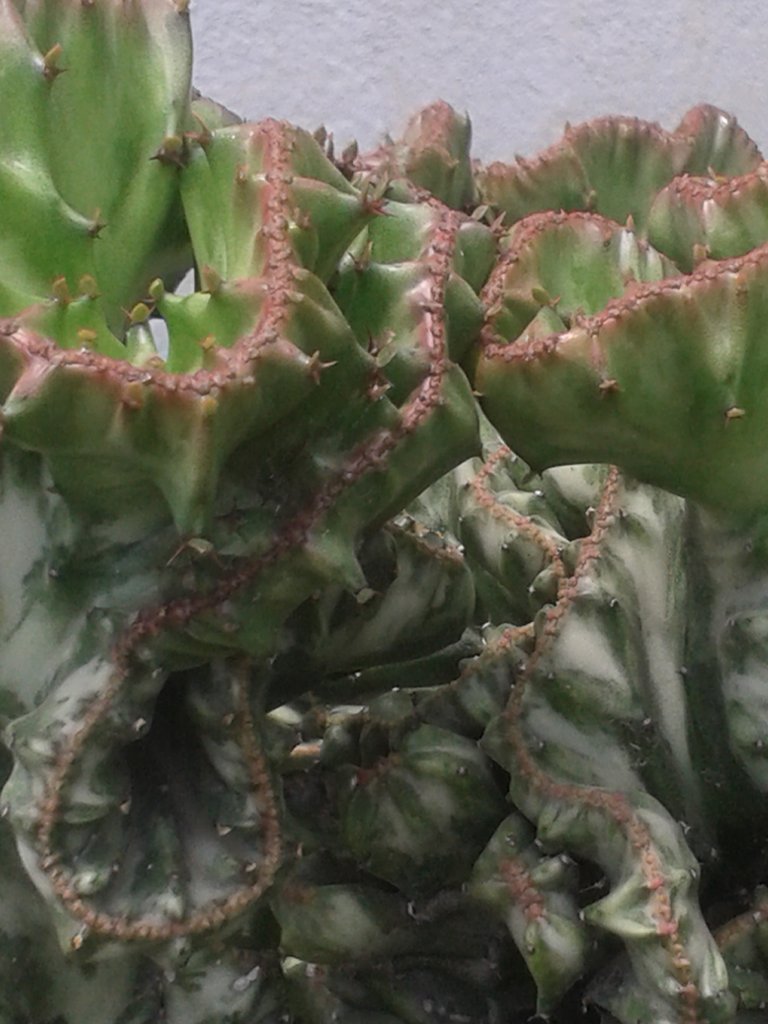
7.- Graptopétallum Paraguayense:
Pertenece a la familia de las crassulaceae. Su género es Graptopétallum y su especie es Paraguayense.
Es originaria de Paraguay, de allí su especie.
El nombre de Graptopétalum se refiere a sus hojas que son un poco manchadas en una coloración blanca grisácea y rosada.
Llamada también Madreperla o planta fantasma. Las hojas de esta planta se disponen en forma de rosetas. Sus hojas son alargadas y gruesas. Estas hojas presentan una coloración entre el verde y el gris o el rosado, con la exposición al sol.
Requiere exposición directa a pleno sol. Soportan las temperaturas medias, si no reciben aportes importantes de agua.
Es una planta que se reproduce en cualquier suelo. Soporta poca humedad de su tierra. Sin riegos en exceso, ya que se pudren las raíces.
Aunque se pueden multiplicar por semillas lo más rápido es por ramas del tallo o de sus hojas. Es muy fácil por su facilidad para enraizar.
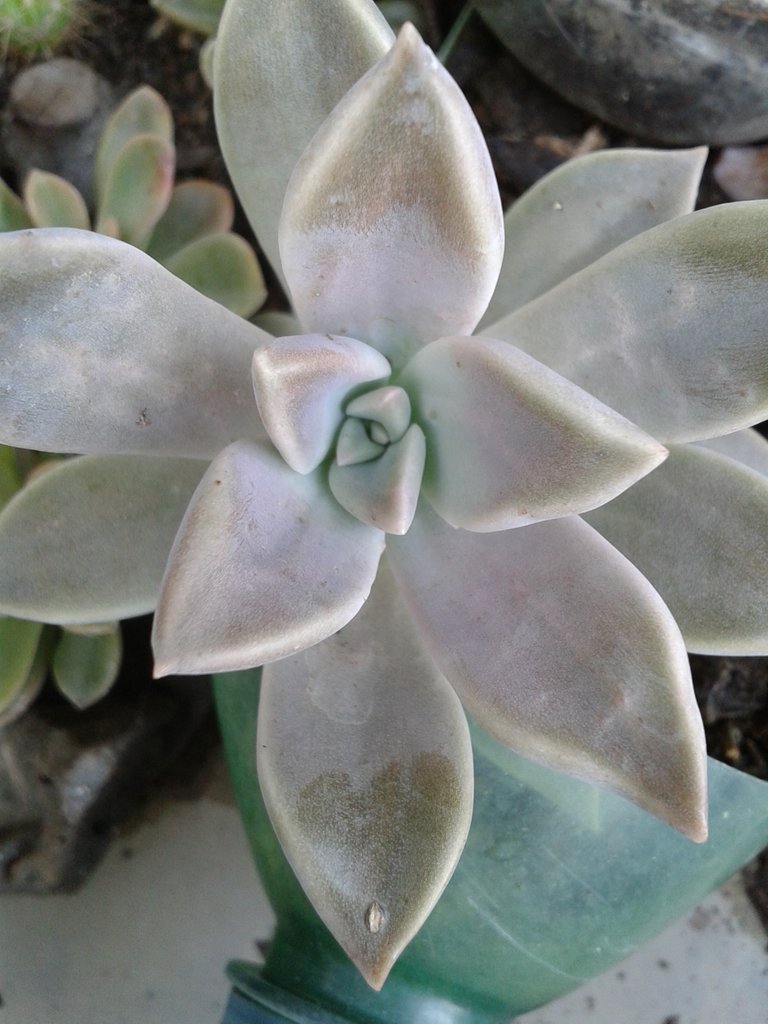
8.- Graptoveria Fenix:
Pertenece a las Crassulaceaes su género es Graptoveria y su especie Fénix.
Proviene de Argentina.
Es una planta con muchas características similares a la Graptopetallum. Con tallos gruesos. Hojas más redondeadas pero igual de carnosas. De color grisaseo. Se disponen en forma de roseta y aglomeradas. La planta no es de gran altura. Su tamaño no sobrepasa los 40 cm. Suele ser más bien rastrera. Ya que presenta tallos erectos y la proliferación de las rosetas hacen que la planta se torne ondulante y caiga por el peso.
La exposición directa al sol permite que sus hojas tomen varios tipos de colores, entre ellos el rojo.
Si se somete a la planta a la semisombra su forma de roseta desaparece y toma otra forma, con las hojas muy separadas. Las hojas se separan en un tallo erecto y rígido sin proliferación de los hijuelos.
No soportan muy bien tiempos prolongados sin suelo húmedo. Pero el exceso de agua pudre sus raíces.
Su reproducción se hace a través de hijuelos. Se retiran de la planta madre y se coloca en la maceta. También puede reproducirse a través de las hojas.
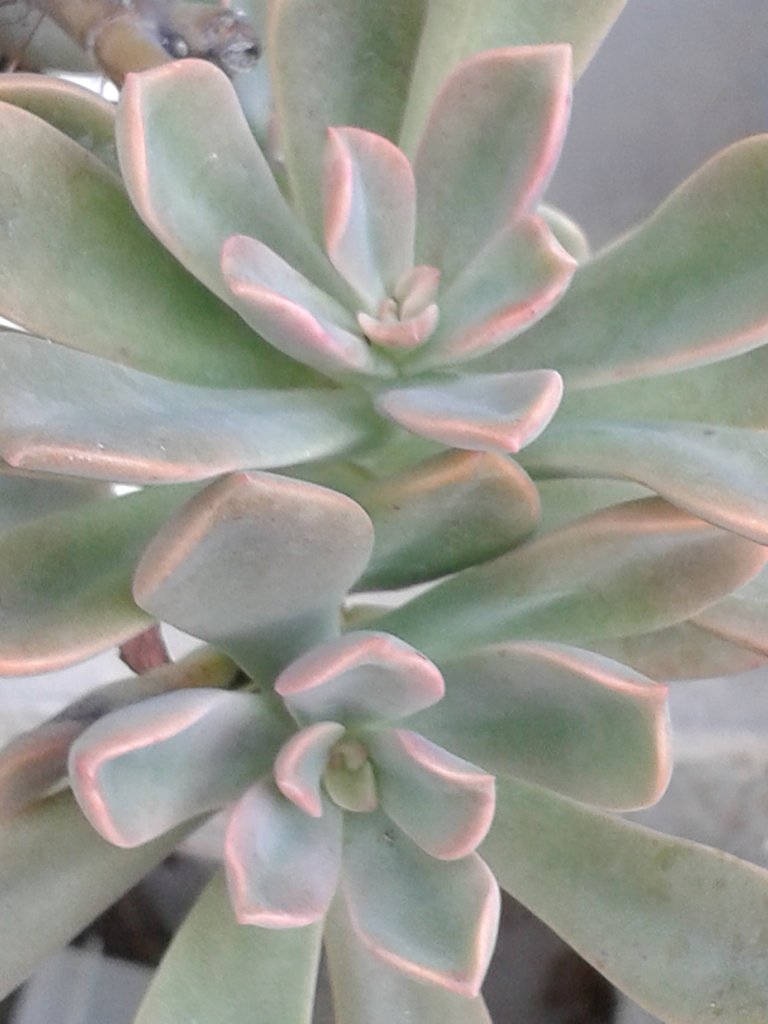
Estas plantas las resguardé de las fuertes lluvias y las coloque en la sombra. Después de unas semanas me doy cuenta que se han dispersado sus hojas por falta de la presencia directa del sol. Aquí se les pierde su atractivo original. Ya no podrá a reagrupar sus hojas aglomeradas, pero las colocaré de nuevo al sol, y así ellas podrán cubrir sus espacios vacíos por hijuelos. Con el tiempo veré su progreso.

9.- El Sedum Morganianum:
Pertenece a la familia de los Crassulaceae, el género es Sedum y la especie Morganianum.
Es originario de Mexico.
Es llamada suculenta Burrito, o cola de Burro. Su tallo está formado por la unión de sus hojas. Que son pequeñas, no sobrepasan los tres cm de largo. Son carnosas y alargadas.
Crecen muy juntas formando largos tallos de más de 30 cm. Son de color verde manzana cuando no están expuestas al sol y de color verde azulado al estar en contacto directo con él. Prefiere la semisombra.
Las condiciones del sustrato deben tener relativa humedad y buen drenaje.
Para esta fecha tiene este tamaño y color.
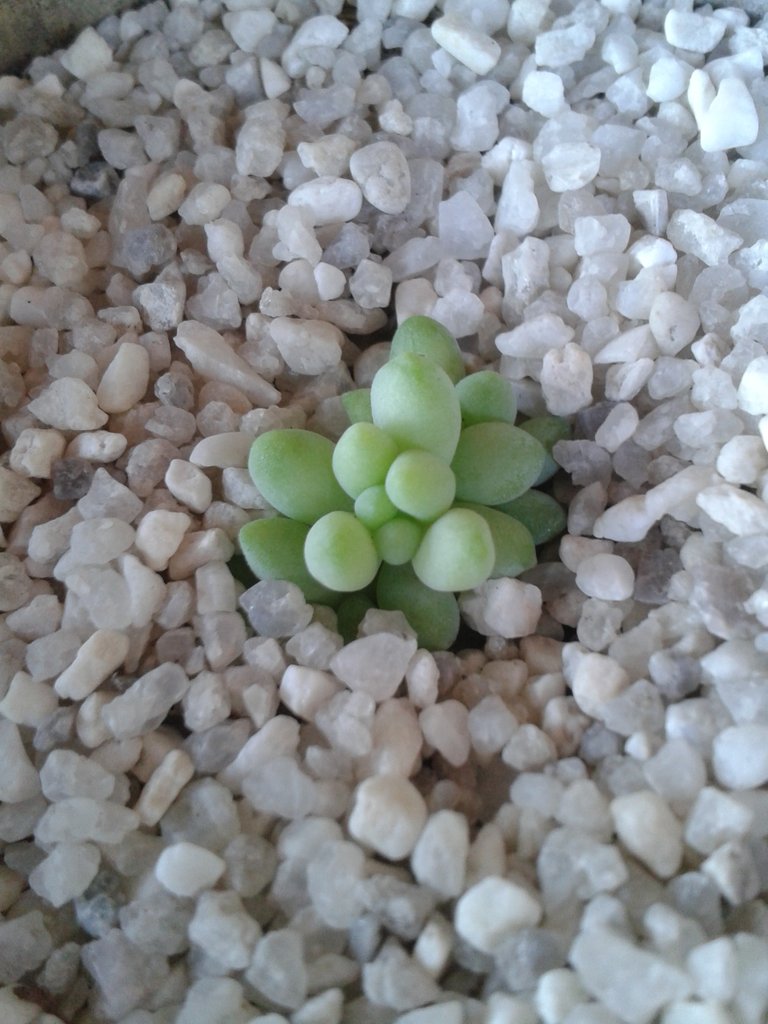
Esta suculenta a crecido a partir de una hoja caída. Desde el año pasado, el 2019, viene creciendo poco a poco en semisombra. He venido siguiendo su desarrollo hasta ahora.
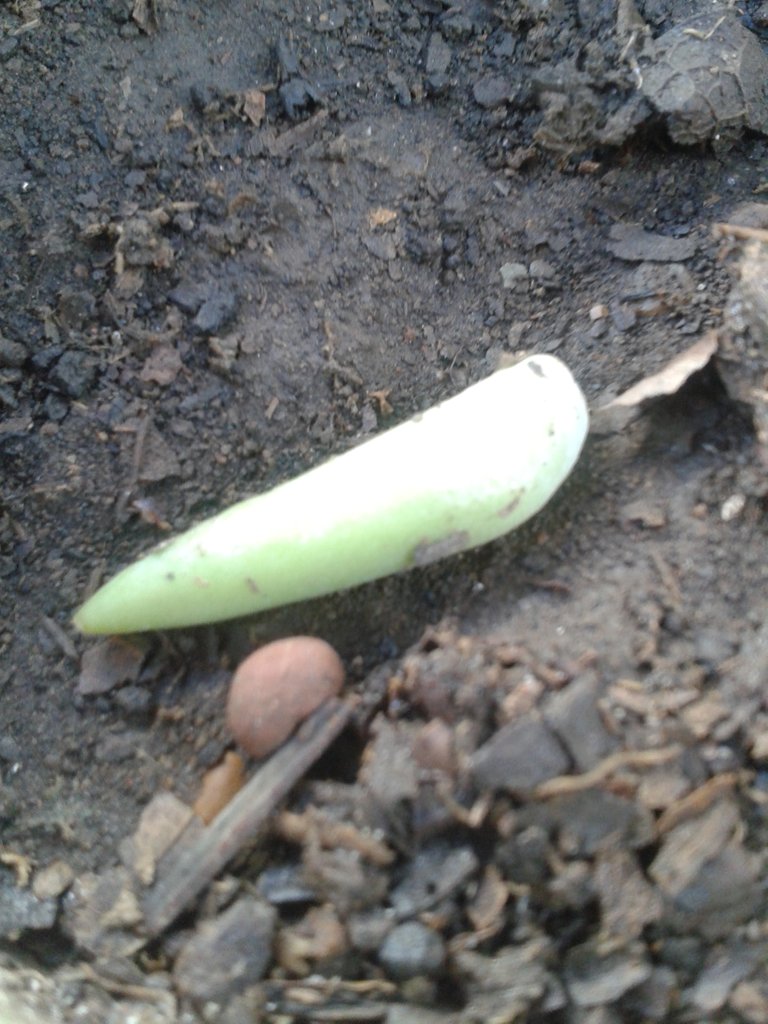
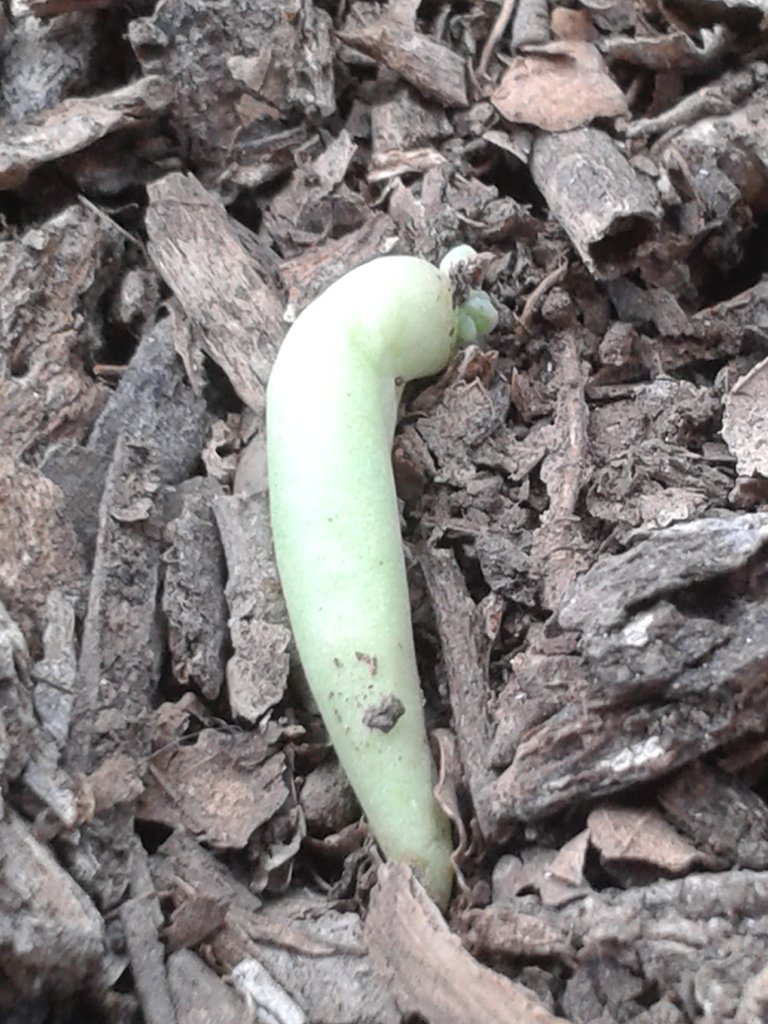
10.- Opuntia Microdasys:
Pertenece a la familia de las cactasseae, el género es Opuntia y la especie Microdasys.
Son originarios de México. Su nombre común es oreja de Mickey, alas de Ángel.
Forman el género de plantas más resistentes que existen. El cuerpo de las Microdasys está formado por la unión de sus pencas. Las pencas o las hojas del cactus crecen en la porción superficial de las orejas. Se disponen de tal manera que forman un cactus muy frondoso que llega a crecer hasta 1 mt de altura.
Las pencas son gruesas, ovaladas, de color verde claro y con vellosidades en toda la superficie del cactus. Estas vellosidades son espinas muy pequeñas, que al contacto con los dedos son muy desagradables y difíciles de retirar.
Les agrada la exposición directa al sol. Y no les agrada el encharcamiento de su sustrato.
Se reproducen fácilmente retirando una de sus pencas y procediendo a dejar cicatrizar por espacio de una semana. Luego se coloca en la maceta en lugar sombreado hasta que pueda exponerse directamente al sol.

11.- Opuntia Rúfida.
Es otra cactáceae de la especie de las Opuntias y su género Rúfida.
La diferencia con la Microdasys es el color de las vellosidades. Son de color rojo. El resto de las características, reproducción y trasplante son las mismas del cactus Microdasys.


Estas son algunas características que he ido obteniendo con mi experiencia con los años de cultivo de los cactus y suculentas. Y averiguando en Google, he podido obtener y recaudar información sobre las especies y géneros. En muchas oportunidades no he estado de acuerdo con cierta información que leo en las redes, por lo tanto solo puedo transmitir lo que a mi me da resultados y son los que acabas de leer. Espero que les sirva si están interesados en su siembra, cultivo y trasplante.
Todas estas plantas representan mi maravillosa naturaleza y espero que la puedan apreciar.
Todas las fotografias son de mi propiedad.
Tomadas con mi teléfono Samsung Mini s3.
Gracias por su visita.

Sooooooo Amazing !! I already waited for this post from you, but it got even bigger and far better then I ever imagined, hehe .. Now you are not allowed anymore to not call you an hivean Cacti expert ^^
Good that you like it. !!
But I think the witnesses are not very fond of cacti.
You saw that it is a complete publication. I've never done it like this.
I have some cacti that I have known all of my life but I do not know their name.
I'll make a post with cactus of unknown name.
But I keep learning from them. I'm not an expert yet !! ...
Thank you very much.
Hehe, nevertheless you did an great job in showing those with the explanations that you know. Maybe the DNA members can help you out with the unknown ones. Unfortunately, my knowledge is really bad when it comes to names ^^ .. And, also the witnesses may not be super fond of cacti, the post is still amazing. I forwarded it to OCD and I see that they appreciate your effort ^^ .. please go on like this !
Thank you very much.
I am very happy ocd went through my publication and it is satisfactory.
Maybe I can have the other group of cactus species for the other contest. I'll see if I can get their names.
I appreciate your love of nature and that you liked my work.
A big virtual hug.
This is a great post!! We really appreciate your work and efforts.
To support your work, we have also up-voted you using our
@dna.orgCuration Trail ✅!Our curators liked your post!
We hope, you'll keep up the good work, and continue posting such articles in the future as well!!
Have a nice day!
Best,
Team DNA 🧬
(Densifying Nature-Appreciation)
By the people ⚪ For the people
You can also consider supporting us with a small delegation / donation.
We are non-profit 😊.
It helps us keep the project alive and running!
Thank you very much for your opinions.
It was really quite an effort to collect all the data from some of my cacti.
Thanks for noticing my effort.
Thank you very much.
La verdad que para la elaboracion de estas plantas que por cierto son muy hermozas, es un trabajo desestrezante y ademas es de mucha creatividad, gracias.
I appreciate your comment.
Having these plants is the effort of a long time working on them. But the most important thing is the fact that I can create new plants, without having prior knowledge of them. But with a lot of love I have managed to reproduce many plants, thanks to the information I now have.
These are simple plants. Now I will go for the most difficult ones.
Thanks for stopping by and leaving your nice comment.
Es asi todo lo hagamos poniendo esfuerzo y amor, sale bien, saludos.
Hola, @gertu.
Interesante compilación de suculentas y cactus.
Detrás de las fotografías está la dedicación que revelan las fotos, se aprecia la calidad de la toma entre luz y color, aunque no sé mucho, pero creo que aprendes rápido porque te apasiona ambas.
Mi fotografía favorita donde están todas.
Gracias querida. Aprecio tu comentario.
Todo lo que se hace con amor se nota en lo que revela. Me apasiona la naturaleza y creo que a ella le agrado yo. Mis éxitos con ellas depende de si lo hago bien o si por el contrario fallo en mis intentos. En caso negativo me entristece que falle en el intento de prosperarlas.
Que bueno que te gusten mis fotos, muchas gracias.